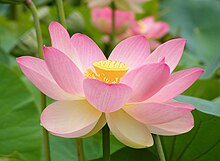Nelumbo
| Nelumbo | |
|---|---|
 |
|
| N. nucifera (sacred lotus) | |
| Scientific classification | |
| Kingdom: | Plantae |
| (unranked): | Angiosperms |
| (unranked): | Eudicots |
| Order: | Proteales |
| Family: | Nelumbonaceae |
| Genus: |
Nelumbo Adans. |
| Species | |
Nelumbo is a genus of aquatic plants with large, showy flowers. Members are commonly called lotus, though "lotus" is a name also applied to various other plants and plant groups, including the unrelated genus Lotus. Members outwardly resemble those in the family Nymphaeaceae ("water lilies"), but Nelumbo is actually very distant to Nymphaeaceae. "Nelumbo" is derived from the Sinhalese word Sinhalese: නෙළුම් neḷum, the name for the lotus Nelumbo nucifera.
There are only two known living species of lotus; Nelumbo nucifera is native to Asia and is better-known. It is commonly cultivated; it is eaten and used in traditional Chinese medicine. This species is the floral emblem of both India and Vietnam.
The other lotus is Nelumbo lutea and is native to North America and the Caribbean. Horticultural hybrids have been produced between these two allopatric species.
A third, extinct species, Nelumbo aureavallis, is known from Eocene fossils from North Dakota in the United States.
There is residual disagreement over which family the genus should be placed in. Traditional classification systems recognized Nelumbo as part of the Nymphaeaceae, but traditional taxonomists were likely misled by convergent evolution associated with an evolutionary shift from a terrestrial to an aquatic lifestyle. In the older classification systems it was recognized under the biological order Nymphaeales or Nelumbonales. Nelumbo is currently recognized as a monotypic taxon, Nelumbonaceae, one of several distinctive families in the eudicot order of the Proteales. Its closest living relatives, the (Proteaceae and Platanaceae), are shrubs or trees.
...
Wikipedia
